Italy Update-2018
by Laurie A. Baum,
MSW
November 2018
The metamorphosis of Italy into an international melting pot is quite symbolic of the transformation the world is going through at this very moment. The Italy I left after living in Florence for a year in 2001-while the same as it was during the Renaissance architecturally and art-wise-is demographically quite a changed place. The old mono-cultural, monochromatic, traditional country I left behind 17 years ago has been transformed, perhaps in many positive expansive ways, both by changing global cultural norms and by massive migration. The changes I observed on this most recent trip were at times expectable, but at other times startling.
Earlier in the 21st century and even earlier this decade, you could hear a pin drop between 1 and 4 pm on the streets of Florence (and most Italian cities and villages) as homogeneous families gathered around dining room tables to share a midday meal and a siesta before returning to work late in the afternoon. The only sounds you would hear through open windows would be the sound of forks hitting plates. The noontime meal and the stopping of all commercial activity was sacrosanct. One of my Italian clients in 2001 told me that in Italy everyone (and he meant it literally) eats breakfast at 8 am, lunch at 1 pm, and dinner at 8 pm. Period. I remember trying to make a purchase in a store at 12:59 pm. The cashier would not take my money. It was her sacred time for lunch. The Italian biological clock was strictly set for a big meal at 1:00 pm!
 |
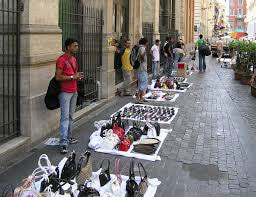 |
| The way it was … And the way it is…. |
But not only have culinary choices and commercial habits completely transformed from quiet storefronts selling Italian goods and services, social mores and relationship patterns also have completely transitioned-to a more liberal, open society that for the most part is accepting, and even welcoming of new cultural additions.
It was heartwarming on this recent visit to see that many Italian families have adopted African children who are living harmoniously with their Italian brothers and sisters. And while in the past, nuns in habits and priests were far more commonly seen in the streets than mixed race couples, cross-cultural dating also is quite evident. Multi-cultural, multi-ethnic, multi-religious couples are rapidly populating this once strictly Catholic country.
It seems as if the world is a big snow globe that's been turned upside down and sideways to allow people of all shades, hues, and heritages to move north and west to assimilate into northern and western societies, creating a multicultural melting pot-once considered only the province of the United States.
I heard so many touching stories during my visit to Italy about Italian natives reaching out to immigrants because they empathized with their struggles. An Italian couple I am friendly with had an extra room in their home, and wondered, "Why don't we give this room to an immigrant who has nowhere to stay?" (I have long contended that it is impossible to be homeless in Italy-someone will inevitably adopt you!) My friends inquired with the Italian government and discovered that they could be paid a monthly stipend to house two immigrants and teach them Italian language classes every morning. So, my friends openheartedly took in a Nigerian mother and her child, and helped them assimilate into the Italian culture. They said this was one of the most rewarding and enriching experiences they have ever had! They see immigrants, who arrive with nothing, as people to embrace, rather than as a phenomenon to be pushed away. (I realize there is a backlash against immigration in the form of the Italian populist movement. But to date, hundreds of thousands of immigrants are successfully assimilating into the Italian population of 61 million.)
In another touching story, I went into one of the many leather shops in Florence because the zipper on my wallet had broken and I was looking for a new wallet. The proprietor of the store was helping me choose a new wallet until I took out my old wallet. He stopped me in my tracks. "Don't buy a wallet from me!" he said emphatically. I looked at him quizzically. He said: "The wallet you have is of higher-quality leather than the one I would sell you, and it is better made. You can have the zipper repaired." My jaw dropped. After so many vendors just outside his door had been hawking their wares and trying to convince me to buy something I didn't need, here was someone trying to convince me not to purchase something I thought I did need. I detected an accent in the way he was speaking Italian, so asked this infinitely kind man where he was from. Looking embarrassed, he dropped his gaze and said, "Don't think poorly of me because of where I'm from." I assured him, "I already think very well of you and it does not matter where you are from." He then told me that he was from Syria, and noticing from my wallet that I was American, he was worried about what I would think about his immigrant status. Quite the contrary! It was my turn to be embarrassed by the image that foreigners hold of Americans. I could not blame him, but tried to reassure him that many Americans, including myself, are sympathetic with his plight.
The cultural transition so evident in Italy was also abundantly visible in fashion realms. Granted, I was in Italy when global warming had raised normal 70-degree September temperatures to the 90s, with humidity. So people's clothing was kept to a minimum-and I mean minimum. African styles of dressing for women, which included 2 vertical strips of cloth draped over the shoulders and held down by a flowing skirts were ubiquitous among African women, and becoming more acceptable by Italian fashionistas. Indian tunics and loose pants also were abundant. And in what maybe be a global rather than an Italian fashion trend, what previously would have been considered lingerie are now considered street clothes.
But the sociological view is truly not the reason I made a pilgrimage to Italia. Last year, my 2 Italian friends and I followed the footsteps of Saint Francis of Assisi to many of the places where he prayed, preached, and lived. Along the way, we stopped at several places where water miraculously sprang from dry earth (and continues to flow hundreds of years later) and we visited the remains of numerous incorrupt saints. We also paid our respects to a number of miraculously preserved Madonnas, and learned about the miracles that occurred for those who prayed to these symbols of the Divine Mother. On this trip, we planned to visit more incorrupt saints and places where miracles had occurred. And along our route, we encountered many surprises and synchronicities that I'd like to share.
One of the stops along our pilgrimage path was in Montefalco, a small hill town near Assisi. We were going to visit the incorrupt remains of Saint Clare of Montefalco (1268-1308; not to be confused with Saint Clare of Assisi, 1194-1253, whose incorrupt remains are found in the Church of St. Clare in Assisi). Several astounding miracles occurred at the Church of Montefalco at the time of Saint Clare of Montefalco's death. Prior to her passing, she told a sister in her convent that she carried the suffering of Christ in her heart, and that if they opened her heart after her passing, they would understand. She also suggested they check her gall bladder for a spiritual teaching. Sure enough, when her heart was opened after her passing, a scene from the Passion of Christ-a cross, 3 nails, crown of thorns, flagellation post, and whip-were formed from the flesh of her heart. The scene inside her heart is incorrupt and still visible today. Secondly, inside her gall bladder, they found 3 fleshy balls, each of which weighed 1 gram. The 3 balls all together also weighed 1 gram, showing the one in the trinity and the trinity in the one.
Another miraculous aspect of this visit concerned a miracle that occurred at the spot where Jesus Christ appeared to Saint Clare of Montefalco in 1294. Jesus said he was looking for a place to plant his cross. She said she would carry the cross for him. He said he would plant it in her heart. At that spot, a tree sprouted that grew only in India. This tree produces green berries that when dried turn brown and resemble "rudraksha"--prayer beads commonly worn by meditators and people engaged in Hindu spiritual practices. The church now uses these beads to fashion rosaries. When we arrived at the Church of St. Clare of Montefalco, we asked to see the tree. The nun-custodian told us that they were harvesting the seeds from the tree-that day! She asked if we wanted some of the beads, which of course we did! (see photo)
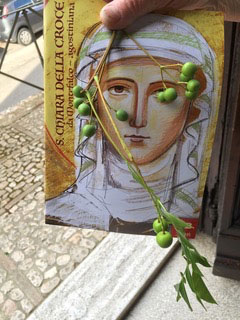
Berries from Miraculous Tree at the Church of St. Clare of Montefalco
Another amazing synchronicity occurred when I visited the Basilica of Santa Croce in Florence. Within moments of walking through the door, a tour guide approached me and asked if she could practice her tour on me. Sure! Italians are notorious for not putting signs at sacred spots, perhaps so as not to attract too much attention. Consequently, holy or historical relics can be easily missed without a bit of research. She explained that the Basilica of Santa Croce, built between 1294 and 1385, is the largest Franciscan churchin the world and the second largest church in Florence. It is in this basilica that Michelangelo, Galileo, the poet Dante, the composer Rossini, and other luminaries are interred. Scores of precious works of Renaissance art and sculpture are also housed within its walls. Noted Renaissance architects such as Brunelleschi and Vasari designed some of the chapels and cloisters within the huge basilica complex, where I routinely meditated during the afternoons when I lived in Florence because of the high vibration of the edifice, with its sacred geometric proportions, marble floors, walls, and cupolas. It was an especially sentimental visit-because of its 700-year history and my own personal history there 17 years ago-plus the rich explanations of the tour guide. She also pointed out a crucifix by Donatello, a fresco by Giotto, a Last Supper by Taddeo Gaddi, a terra cotta altarpiece by Andrea della Robbia, terra cotta sculptures of the 12 apostles by Luca della Robbia, and another crucifix by Cimabue. Italian churches are truly richer in masterpieces than some museums!
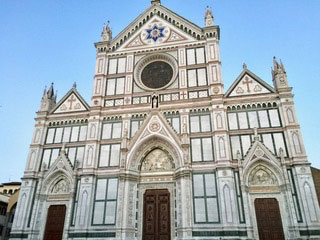
Basilica of Santa Croce, Florence
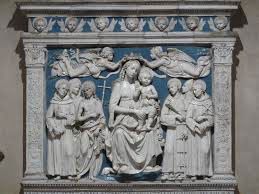
Madonna with Child and Saints, by Andrea della Robbia, Basilica of Santa Croce, Florence
The tour guide then asked me, since I speak Italian, if I would like to meet the curator of the church's museum. Of course! So we met with a small Italian man who looked like an elf. He animatedly explained more about the history of the church, and he asked me if I knew why the church was called the Basilica of Santa Croce (Holy Cross)? I didn't. He excitedly told me that it is because the church has in its possession a piece of the cross upon which Jesus was crucified. The next logical question, of course, was, "Where is it?" He said that the "holy cross" was only on display twice a year. "When would that be?" I asked. He said, "Only in May and September." "Well, it is September!" I said as my level of excitement rose. Hmmm, he scratched his chin. He couldn't remember the date in September when the relic would be displayed, so he ran back to his office, and quickly returned, feet barely touching the ground. "They will display the holy cross tomorrow!" Needless to say, I returned early the next morning to experience the holy cross. (see photo)
-.jpg) |
2.jpg) |
| The Holy Cross (Wood from the Cross upon which Jesus Christ was Crucified) |
In a land steeped in spiritual tradition, it somehow was seeming easier than normal for synchronicities to occur for those who are receptive. At least that's what we experienced as we worked our way from Padua, to Florence, to Assisi, and Siena.
Another aspect of our visit to Florence involved the viewing of 7 "Last Suppers" that had been frescoed on the refectory walls of various monasteries and convents in Florence during the early Renaissance. Originally, I had been fascinated with Leonardo da Vinci's "Last Supper," which was painted from 1495-98 on the refectory wall of the Convent of Santa Maria delle Grazie in Milan. It turns out that large renderings of the "Last Supper" were commonly frescoed on refectory walls of monasteries and convents so that monks and nuns could reflect upon the life of Jesus Christ while they were eating in silence.
An internet search fortuitously led me to discover that there were 7 more floor-to-ceiling "Last Suppers" frescoed on the walls of Florentine convents and monasteries from 1334 to 1514, some of which were, unbeknownst to me, steps from where I lived in the center of Florence 17 years ago. Even my friends who'd lived in Florence all of their lives were unaware of the existence of these masterpieces. So, off we went to experience these Renaissance artifacts.
Even though I would study the frescoes in advance and be aware of their large dimensions (some more than 20 feet high x 30 feet wide), I would gasp every time we'd walk into the rooms where they were preserved. The element that was so thrilling was that the perspective was so well-depicted, you would feel as if you were about to walk into the room where Jesus ate his last supper. In one case, I was sure there was a ledge protruding from the bottom of the painting and a covering extending from the top. Upon approaching the painting more closely, I discovered that it was entirely flat! The expressions on the faces or Jesus and the 12 apostles were so lifelike, it was almost as if I could hear their voices! I later learned that the masterpieces were designed to draw the viewer spatially and emotionally into the painting so they could feel the trepidation of being with Jesus at the Last Supper as well as the thrill of being in his presence. The lighting in the paintings also was so lifelike as it harmonized with the natural lighting from the windows in the rooms where they were frescoed. It was a challenge to discern whether the light in the painting was coming from the window or was in the painting itself. I also learned that the reason the frescoes' colors were so bright and brilliantly preserved after more than 500 years was because the "paints" were made of ground-up semi-precious gems, such as lapis lazuli and malachite, and from ground-up gold, plants, and even insects. The frescoes are so filled with energy that they seemed practically alive! All of which added to the mystique of this journey that was taking us back to a time that we consider more primitive but in many ways was more artistically refined than today.
The discovery of the 7 Last Suppers, called (called "cenacoli" in Italian) made me realize that Italy is a spiral that will take you deeper and deeper into the past if you let it carry you into its historical depths. The country practically breathes a history that makes you feel your own ancient roots in humanity. Here are a few examples of the Last Suppers "Cenacoli" on floor-to-ceiling refectory walls in Florence, Italy.
-by-Ghirlandaio;-1480-3-Last-Supper-by-del-Sarto,-1511-27.jpg)
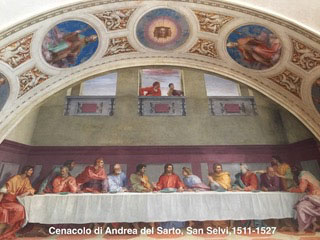
Last Supper ("Cenacolo") by Ghirlandaio; 1480-3 Last Supper by del Sarto, 1511-27
Floor and/or Ceiling Appear Protruding but are Flat Surface, Paints Made from Ground Gems, Plants & Insects
The first of the above frescoes was painted prior to Leonardo da Vinci's Last Supper & the second was painted afterwards (see Da Vinci's masterpiece below):
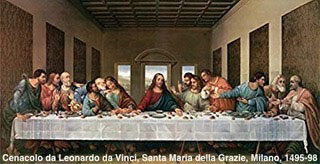
Last Supper by Da Vinci, 1495-8
The final synchronicity of our pilgrimage occurred in Siena, where we were visiting the incorrupt remains of Saint Catherine of Siena, whose writings have always inspired me. There we stumbled upon Siena's Church of Saint Francis, where another miracle had occurred. In 1730, a gold tabernacle containing 351 communion wafers (aka Eucharistic hosts) had been stolen during the Feast of the Assumption of the Virgin Mary. Called the "Eucharistic Miracle," the wafers were found 50 years later -completely intact - and they remain intact to this day, 288 years later! To prove the wafers' immutability, a scientific study was undertaken to discover the amount of time in which the wafers would decompose under normal conditions. Under similar circumstances, decomposition would begin after 4 years. Pope John Paul in 1980 declared the wafers to be evidence of "the presence of Christ." The "Miraculous Eucharist" is on view only once a month and it happened to be the day we were in Siena! This is just one of the many, maybe thousands of miraculous manifestations of the Divine that you can routinely find in Medieval and Renaissance-era churches throughout Italy.
 |
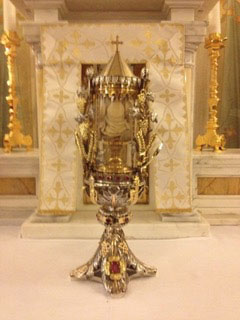 |
| Miraculously Preserved Eucharist on display in Siena, Italy |
Perhaps miracles such as these were the Divine's way of making itself known in manifest form in a lower age when the consciousness needed miracles as proof of the existence of the Divine. Or, perhaps there is something special about the land of Italy in that it has been blessed over the ages by the presence of so many saints. One does not have to look very far in this country to see evidence of a divine hand. Inevitably, our awareness of the divine presence in a faraway land reminds us that the Divine is everywhere, and if we all pray strongly enough, the Divine presence will manifest in a helpful way here too! This is important to keep in mind in these somewhat turbulent times. If we are receptive, we will feel it too.
If you would like to read more about my last trip to Italy, click here for "Following the Footsteps of the Saints & Finding Miracles in Italy" and "Miracles and Madonnas in Italy".
***